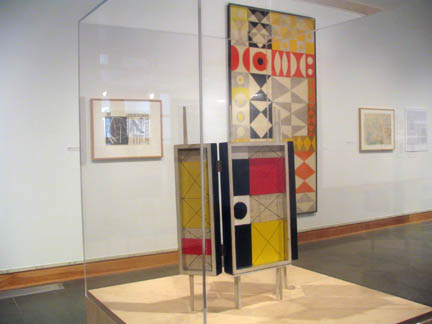June 16 to September 9, 2007
The Kelowna Art Gallery is pleased to present the exhibition B.C. Binning, an instalment in the Vancouver Art Gallery’s provincial touring program – Across the Province – circulating exhibitions drawn from the VAG’s permanent collection.
Bertram Charles Binning (1909-1976) was one of Canada’s foremost modern artists, architectural innovators and art educators. The exhibition is comprised of more than 50 retrospective works providing a comprehensive look at the artist’s prolific career and illuminates his transformative ideas that revolutionized the art world of British Columbia.
Binning trained at the Vancouver School of Decorative and Applied Arts where he worked under the guidance of famed Canadian painters Jock Macdonald and Group of Seven member Fred Varley. Following a period of teaching at the school in the early 1930s, he traveled to England where he studied with modernist sculptor Henry Moore. In the 1940s, after returning to Vancouver, Binning developed a remarkable skill as a draughtsman and exhibited drawings throughout Canada. Characterized by exceptional elegance and control of line, his early drawings demonstrate Binning’s complete assimilation of such diverse influences as Moore, Pablo Picasso and Henri Matisse, as well as his exceptional skill in working with pattern and form.
Beginning in 1947, Binning devoted himself to painting and produced an important body of maritime images. These works are imbued with an innate sense of delight in the world and feature a strong sense of linear design and clear colour, representative of his profound belief in order and composition. At the end of the 1940s, Binning began teaching at the University of British Columbia, first in the Department of Architecture and, after he established it, as the head of the Fine Arts Department, making him a pivotal figure in campus life.
The 1950s marked Binning’s involvement in a number of architectural projects, including his now iconic flat-roofed home where he lived the majority of his life, as well as murals and decorative mosaics, which illustrate his ongoing interest in design, art historical precedence and his engagement with contemporary culture. He admired the mosaic traditions of Venice and took his design for a stylized Imperial Bank mural to Italy, where it was transformed into a vast mosaic employing coloured stones and glass tesserae. The Maquette for the Imperial Bank Mural, on display in the exhibition, remains one of his most vibrant works, artfully combining his deep affinity for linear pattern, bold colour sense and profound feeling for British Columbia. By 1960 Binning had moved away from the more insistent patterning that characterized his work of the previous decade. In a series of highly reduced landscapes, many of which recall both the American painter Mark Rothko and the sublime seascapes of Turner, Binning explored the use of non-naturalistic colour and bold expressive forms. His final great body of work was the Optional Modules, a series first shown in Vancouver in 1970. These paintings represent a continuation of his interest in design, colour and form, but also required the direct participation of the viewer, requiring them to move around the work in order to comprehend it.
Although it has been more than thirty years since Binning’s death, his art continues to attract new attention and admiration. His strong sense of design, brilliant and subtle use of colour and interesting experiments with texture allow his paintings to speak to a new generation of artists and designers, who recognize Binning as one of the major figures in the history of modernism in Canada.
B.C. Binning is organized and circulated by the Vancouver Art Gallery with the generous support of RBC Foundation.











